An Internal Defect Detection Algorithm for Concrete Blocks Based on Local Mean Decomposition-Singular Value Decomposition and Weighted Spatial-Spectral Entropy
Abstract
:1. Introduction
2. Theoretical Description and Algorithmic Steps
2.1. LMD-SVD Signal Denoising
2.1.1. LMD Principle
- Calculate the Pearson correlation coefficient between the PF signal and the original signal. Discard the PF signal if the correlation coefficient is less than 0.1. This step serves to eliminate the extraneous and irrelevant PF signals produced during the decomposition process.
- Combining the PF signals with correlation coefficients exceeding 0.7 as PFC1 and those between 0.1 and <0.7 as PFC2. Subsequently, denoise these two PF components using SVD. This step is to decrease the computational complexity of denoising while preserving the vibration characteristics of the signal.
2.1.2. SVD Principle
2.1.3. Singular Value Selection Algorithm Based on Singular Entropy Increment
2.2. Theory of WSSE Algorithm
2.2.1. Spectrum Entropy (SE) and Spatial Spectral Entropy (SSE)
2.2.2. WSSE Algorithm
- Compute the average value of the vibration energy at each measurement point at frequency f for the NEP group data to obtain the average vibration amplitude sequence Gmean. After arranging Gmean in ascending order, compute the median of the reordered sequence as the threshold T1.
- Rearrange Gmean into a matrix according to the scanned grid size, and define this matrix as Gmatrix. Define all the edge points of Gmatrix as a set denoted EDall, and then calculate the vibration amplitudes of all the measurement points in EDall at frequency f.
- Calculate the average vibration amplitudes of all elements in Gmatrix with amplitudes larger than T1, and record this average value as the threshold T2. Then, count the number of measurement points with a vibration energy larger than T2 in EDall. Denote the selected edge measurement points as a set of EDs.
2.3. LMD-SVD-WSSE Algorithm Flow
3. Experimental Environment and Testing
3.1. Fabrication of Experimental Test Blocks
3.2. Experimental Environment and Test
4. Experimental Results and Analysis
4.1. Measurement Signal Analysis
4.2. Differences in Compared Defective Resonant Frequency Identification Methods
4.3. Analysis of the Vibration Shape Characteristics of the Test Block
5. Conclusions
Author Contributions
Funding
Institutional Review Board Statement
Informed Consent Statement
Data Availability Statement
Conflicts of Interest
References
- Liu, J.; Xie, J.; He, X.Y.; He, Y.S.; Zhong, J.H. Detecting the Defects in Concrete Components with Impact-echo Method. Appl. Mech. Mater. 2014, 577, 1114–1118. [Google Scholar] [CrossRef]
- Geng, H.J.; Liu, R.G.; Cai, D.S.; Xie, F.Z.; Tang, X.W.; Zhou, H.J. Study on quantitative detection of defects of concrete members by impact-echo method. Concrete 2021, 11, 150–154. (In Chinese) [Google Scholar] [CrossRef]
- Yamada, M.; Yagi, Y.; Ohtsu, M. Identification of Delamination in Concrete Slabs by SIBIE Procedure. J. Phys. Conf. Ser. 2017, 842, 012036. [Google Scholar] [CrossRef]
- Le Bastard, C.; Pan, J.; Wang, Y.; Sun, M.; Todkar, S.S.; Baltazart, V.; Pinel, N.; Ihamouten, A.; Derobert, X.; Bourlier, C. A Linear Prediction and Support Vector Regression-Based Debonding Detection Method Using Step-Frequency Ground Penetrating Radar. IEEE Geosci. Remote Sens. Lett. 2018, 16, 367–371. [Google Scholar] [CrossRef]
- Yehia, S.; Qaddoumi, N.; Farrag, S.; Hamzeh, L. Investigation of concrete mix variations and environmental conditions on defect detection ability using GPR. NDT E Int. 2014, 65, 35–46. [Google Scholar] [CrossRef]
- Jiao, L.B.; Ye, Q.L.; Cao, X.H.; Huston, D.; Xia, T. Identifying concrete structure defects in GPR image. Measurement 2020, 160, 107839. [Google Scholar] [CrossRef]
- Rossi, E.; Polder, R.; Copuroglu, O.; Nijland, T.; Šavija, B. The influence of defects at the steel/concrete interface for chloride-induced pitting corrosion of naturally-deteriorated 20-years-old specimens studied through X-ray Computed Tomography. Constr. Build. Mater. 2022, 235, 117474. [Google Scholar] [CrossRef]
- Sugiyama, S.; Promentilla, M. Advancing Concrete Durability Research through X-ray Computed Tomography. J. Adv. Concr. Technol. 2021, 19, 730–735. [Google Scholar] [CrossRef]
- Milovanović, B.; Banjad, P.I.; Štirmer, N. The methodology for defect quantification in concrete using IR thermography. J. Civ. Eng. Manag. 2017, 23, 573–582. [Google Scholar] [CrossRef] [Green Version]
- Janků, M.; Březina, I.; Grošek, J. Use of Infrared Thermography to Detect Defects on Concrete Bridges. Procedia Eng. 2017, 190, 62–69. [Google Scholar] [CrossRef]
- Concu, G.; Trulli, N. Concrete Defects Sizing by Means of Ultrasonic Velocity Maps. Buildings 2019, 8, 176. [Google Scholar] [CrossRef] [Green Version]
- Sun, Y.S.; Wang, G.H.; Li, Y.X. Study on Ultrasonic Nondestructive Testing of Self-Compacting Concrete under Uniaxial Compression Test. Materials 2022, 15, 4412. [Google Scholar] [CrossRef] [PubMed]
- Zhu, W.F.; Shao, W.; Peng, L.L.; Fan, G.P.; Chen, X.J.; Zheng, S.B.; Zhang, H.Y. Time-Domain Topological Energy Imaging Method of Concrete Cavity Defect by Lamb Wave. Shock Vib. 2019, 2019, 6294603. [Google Scholar] [CrossRef] [Green Version]
- Rhim, H.C.; Kim, D.Y.; Cho, C.S.; Kim, D.H. Effect of Steel Plates on Estimation of the Compressive Strength of Concrete via Ultrasonic Testing. Materials 2020, 13, 887. [Google Scholar] [CrossRef] [PubMed] [Green Version]
- Liu, W.B.; Li, J.; Yang, J.X.; Jia, H.L.; Pan, W.M. Detection of concrete defects in steel tube lining by impact echo method. Nondestruct. Test. 2021, 43, 47–51. (In Chinese) [Google Scholar] [CrossRef]
- Qiu, Q.W. Imaging techniques for defect detection of fiber reinforced polymer-bonded civil infrastructures. Struct. Control Health Monit. 2020, 27, e2555. [Google Scholar] [CrossRef]
- Sirca, G.F.J.; Adeli, H. Infrared thermography for detecting defects in concrete structures. J. Civ. Eng. Manag. 2018, 24, 6–8. [Google Scholar] [CrossRef]
- Abdul, W.; Md, M.A.A.; Abdul, R.M.S.; Kok, Y.Y.; Abdul, Q.B.; Khairul, A.K. Review on microwave nondestructive testing techniques and its applications in concrete technology. Constr. Build. Mater. 2019, 209, 135–146. [Google Scholar] [CrossRef]
- Dong, W.; Wu, Z.M.; Zhou, X.M.; Tan, Y.J. Experimental studies on void detection in concrete-filled steel tubes using ultrasound. Constr. Build. Mater. 2016, 128, 154–162. [Google Scholar] [CrossRef] [Green Version]
- Hernandez-Valle, F.; Dutton, B.; Edwards, R.S. Laser ultrasonic characterisation of branched surface-breaking defects. NDT E Int. 2014, 68, 113–119. [Google Scholar] [CrossRef]
- Zhou, Z.G.; Zhang, K.S.; Zhou, J.H.; Sun, G.K.; Wang, J. Application of laser ultrasonic technique for non-contact detection of structural surface-breaking cracks. Opt. Laser Technol. 2015, 73, 173–178. [Google Scholar] [CrossRef]
- Landahl, S.; Terry, L.A. Non-destructive discrimination of avocado fruit ripeness using laser Doppler vibrometry. Biosyst. Eng. 2020, 194, 251–260. [Google Scholar] [CrossRef]
- Yan, S.; Li, B.; Li, B.Q.; Li, F. Application of 3-D Scanning Vibrometry Technique in Liquid Rocket Engine Modal Test. J. Astronaut. 2017, 38, 97–103. (In Chinese) [Google Scholar]
- Kumar, D.; Agrawal, A.K.; Cao, R.; Zhan, L.H.; Wei, J. Damage Detection in Concrete Slab Using Smart Sounding. In Proceedings of the 10th European Workshop on Structural Health Monitoring (EWSHM), Palermo, Italy, 4–7 July 2022. [Google Scholar]
- Wakata, S.; Hosoya, N.; Nishikino, M. Defect detection of concrete in infrastructure based on Rayleigh wave propagation generated by laser-induced plasma shock waves. Int. J. Mech. Sci. 2022, 218, 107039. [Google Scholar] [CrossRef]
- Hashimoto, K.; Shiotani, T.; Ohtsu, M. Application of Impact-Echo Method to 3D SIBIE Procedure for Damage Detection in Concrete. Appl. Sci. 2020, 10, 2729. [Google Scholar] [CrossRef] [Green Version]
- Zhang, X.; Zhou, D.Y.; Tang, H.S.; Han, X. Experimental study of grout defect identification in precast column based on wavelet packet analysis. Int. J. Distrib. Sens. Netw. 2019, 15, 155014771988959. [Google Scholar] [CrossRef]
- Słoński, M.; Schabowicz, K.; Krawczyk, E. Detection of Flaws in Concrete Using Ultrasonic Tomography and Convolutional Neural Networks. Materials 2020, 13, 1557. [Google Scholar] [CrossRef] [PubMed] [Green Version]
- Tian, X.; Ao, J.; Ma, Z.Z.; Jian, B.J.; Ma, C.B. Concrete Multi-Type DefectClassification Algorithm Based on MSSMA-SVM. Sensors 2022, 22, 9145. [Google Scholar] [CrossRef]
- Lin, S.B.; Shams, S.; Azari, H. Ultrasonic imaging of multi-layer concrete structures. NDT E Int. 2018, 98, 101–109. [Google Scholar] [CrossRef]
- Zhu, W.F.; Chen, X.J.; Li, Z.W.; Meng, X.Z.; Fan, G.P.; Shao, W.; Zhang, H.Y. A SAFT Method for the Detection of Void Defect inside a Ballastless Track Structure Using Ultrasonic Array Sensors. Sensors 2019, 19, 4677. [Google Scholar] [CrossRef] [Green Version]
- Knak, M.; Wojtczak, E.; Rucka, M. Non-Destructive Diagnostics of Concrete Beams Strengthened with Steel Plates Using Modal Analysis and Wavelet Transform. Materials 2021, 14, 3014. [Google Scholar] [CrossRef] [PubMed]
- Fang, L.; Zhou, Y.; Jiang, Y.Z.; Pei, Y.L.; Yi, W.J. Vibration-Based Damage Detection of a Steel-Concrete Composite Slab Using Non-Model-Based and Model-Based Methods. Adv. Civ. Eng. 2020, 2020, 8889277. [Google Scholar] [CrossRef]
- Buka-Vaivade, K.; Gaile, L.; Serdjuks, D.; Tatarinovs, A.; Pakrastins, L. Non-Destructive Quality Control of the Adhesive Rigid Timber-to-Concrete Connection in TCC Structures. Buildings 2022, 12, 2151. [Google Scholar] [CrossRef]
- Kasahara, J.Y.L.; Yamashita, A.; Fujii, H.; Asama, H. Weakly Supervised Acoustic Defect Detection in Concrete Structures Using Clustering-Based Augmentation. IEEE/ASME Trans. Mech. 2021, 26, 2826–2834. [Google Scholar] [CrossRef]
- Mao, Q.Q.; Chen, X.; Shi, W.Z.; Lu, C.; Li, Q.F. Research on synthetic aperture focusing ultrasonic imaging based on phase coherence in frequency domain. Chin. J. Sci. Instrum. 2020, 41, 136–143. (In Chinese) [Google Scholar] [CrossRef]
- Yasuda, N.; Misaki, N.; Shimada, Y.; Yamaoka, D. Detection and characteristics estimation of defects in concrete structures using laser ablation-induced vibration. Tunn. Undergr. Space Technol. 2020, 103, 103460. [Google Scholar] [CrossRef]
- Shimada, Y.; Kotyaev, O.; Kurahashi, S.; Yasuda, N.; Misaki, N.; Takayama, Y.; Soga, T. Development of Laser-based Remote Sensing Technique for Detecting Defects of Concrete Lining. Electron. Commun. Jpn. 2019, 102, 12–18. [Google Scholar] [CrossRef]
- Yasuda, N.; Misaki, N.; Shimada, Y.; Kotyaevl, O. Applicability of non-contact inspection using laser ablation-induced vibration in a reinforced concrete tunnel lining. Tunn. Undergr. Space Technol. 2021, 113, 103977. [Google Scholar] [CrossRef]
- Sugimoto, K.; Sugimoto, T.; Kuroda, C.; Kawakami, A. Detection of internal defects of concrete structures based on statistical evaluation of healthy part of concrete by the noncontact acoustic inspection method. Jpn. J. Appl. Phys. 2018, 57, 07LC13. [Google Scholar] [CrossRef]
- Sugimoto, K.; Sugimoto, T.; Utagawa, N.; Kuroda, C. Detection of resonance frequency of both the internal defects of concrete and the laser head of a laser Doppler vibrometer by spatial spectral entropy for noncontact acoustic inspection. Jpn. J. Appl. Phys. 2019, 58, SGGB15. [Google Scholar] [CrossRef]
- Sugimoto, K.; Sugimoto, T. Detection of Internal Defects in Concrete and Evaluation of a Healthy Part of Concrete by Noncontact Acoustic Inspection Using Normalized Spectral Entropy and Normalized SSE. Entropy 2022, 24, 142. [Google Scholar] [CrossRef] [PubMed]
- Qiu, Q.W.; Lau, D. A novel approach for near-surface defect detection in FRP-bonded concrete systems using laser reflection and acoustic-laser techniques. Constr. Build. Mater. 2017, 141, 553–564. [Google Scholar] [CrossRef]
- Zhang, X.M.; Tang, J.; Zhang, M.J.; Ji, Q.C. Noise subspaces subtraction in SVD based on the difference of variance values. J. Vibroeng. 2016, 18, 4852–4861. [Google Scholar] [CrossRef] [Green Version]
- Gao, S.J.; Wu, S.J.; Zhou, J.H.; Zheng, P.; Chen, B.; Xu, J.C. Fault Diagnosis Method of Planetary Gearboxes Based on LMD Permutation Entropy and BP Neural Network. J. Mech. Transm. 2022, 46, 10–16. (In Chinese) [Google Scholar] [CrossRef]
- Li, M.Z.; Wang, Z.Q.; Luo, J.; Liu, Y.S.; Cai, S. Wavelet Denoising of Vehicle Platform Vibration Signal Based on Threshold Neural Network. Shock Vib. 2017, 2017, 7962828. [Google Scholar] [CrossRef] [Green Version]
- Wang, Q.; Wang, L.; Yu, H.; Wang, D.; Nandi, A.K. Utilizing SVD and VMD for Denoising Non-Stationary Signals of Roller Bearings. Sensors 2022, 22, 195. [Google Scholar] [CrossRef]
- Ahn, J.-H.; Kwak, D.-H.; Koh, B.-H. Fault Detection of a Roller-Bearing System through the EMD of a Wavelet Denoised Signal. Sensors 2014, 14, 15022–15038. [Google Scholar] [CrossRef] [Green Version]
- Smith, J.S. The local mean decomposition and its application to EEG perception data. J. R. Soc. Interface 2005, 2, 443–454. [Google Scholar] [CrossRef]





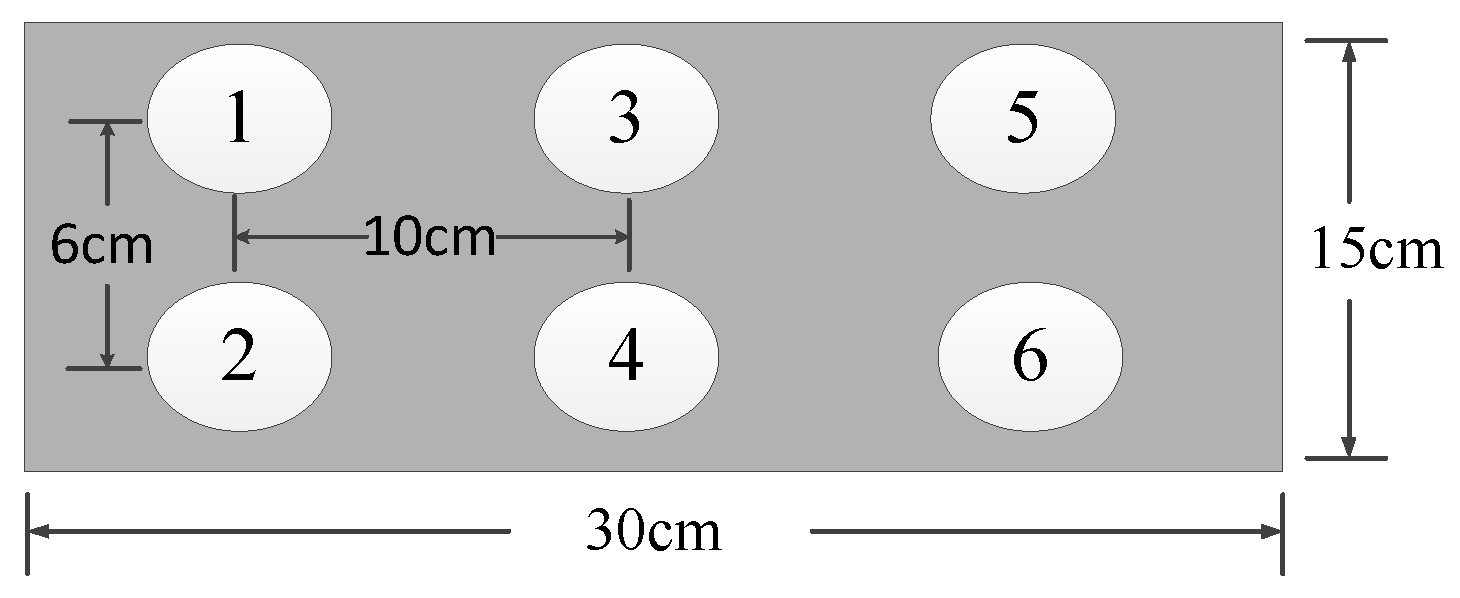



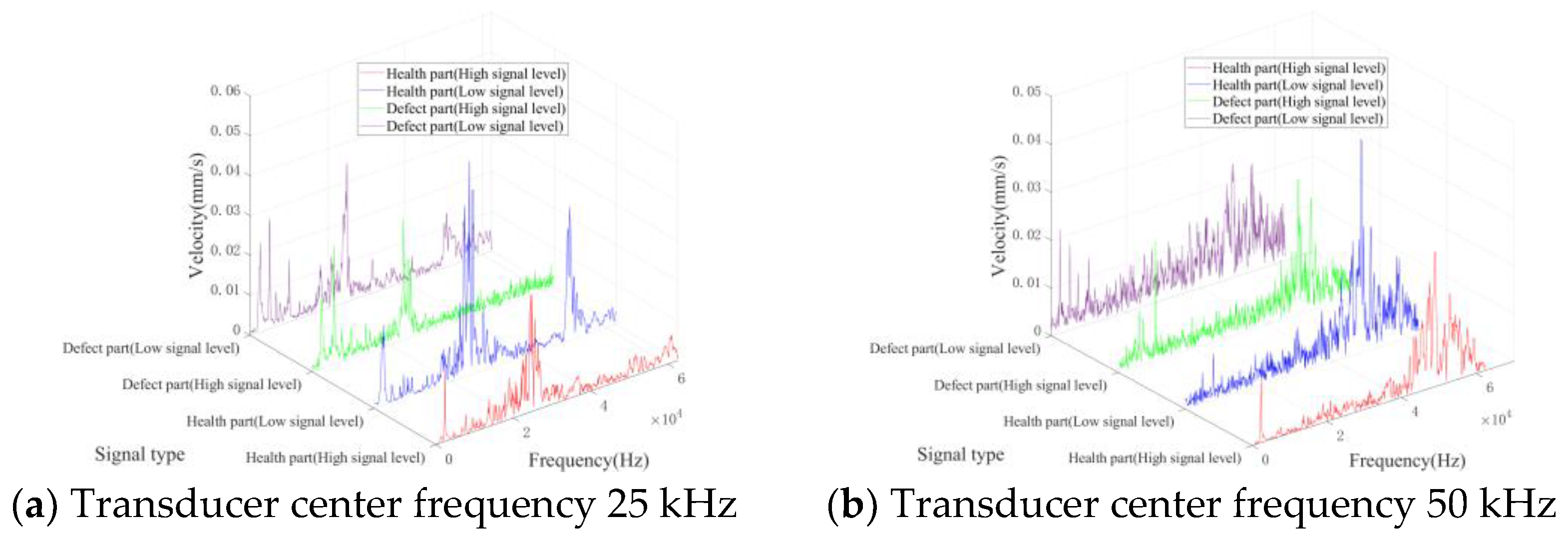
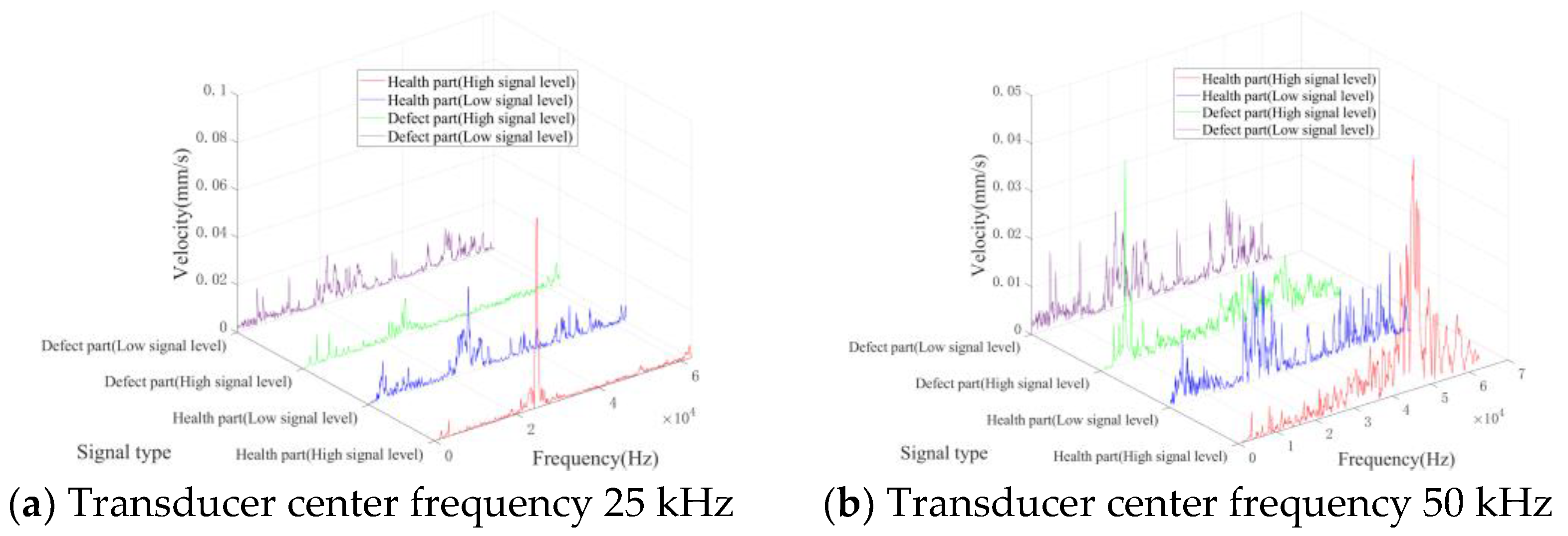

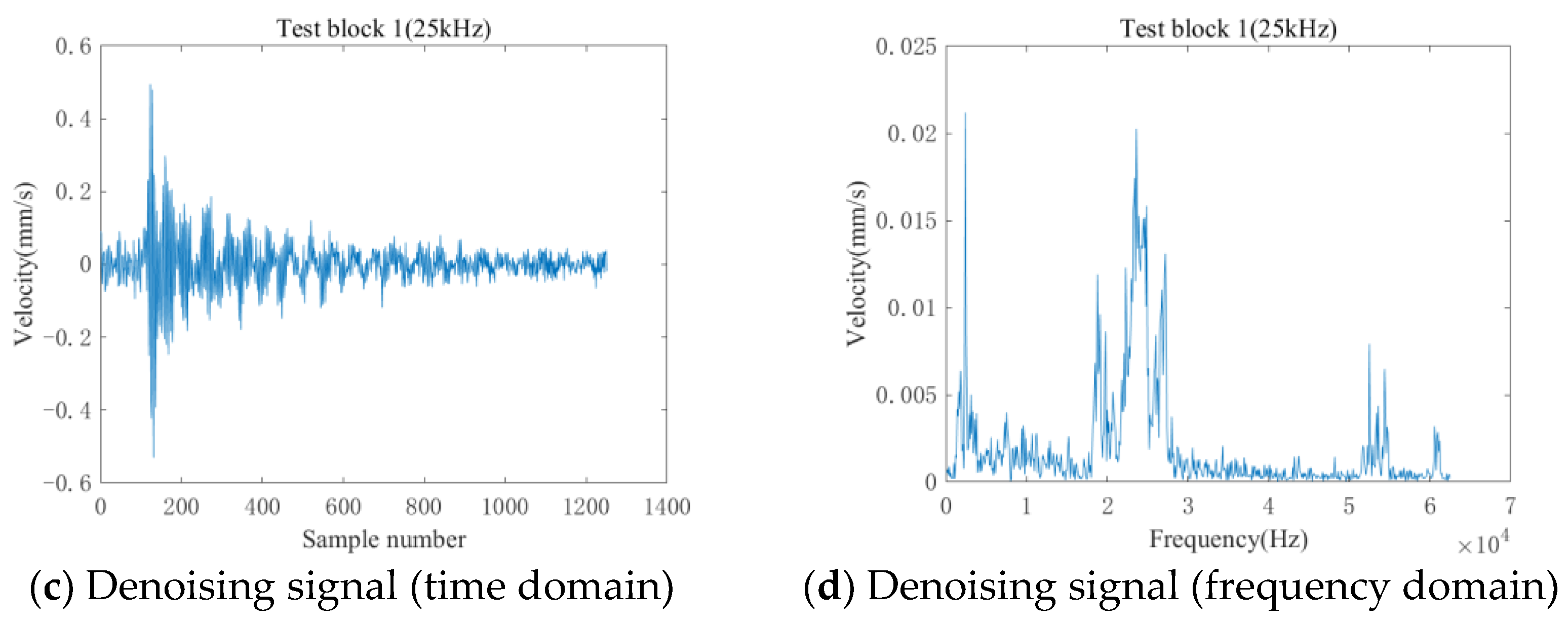

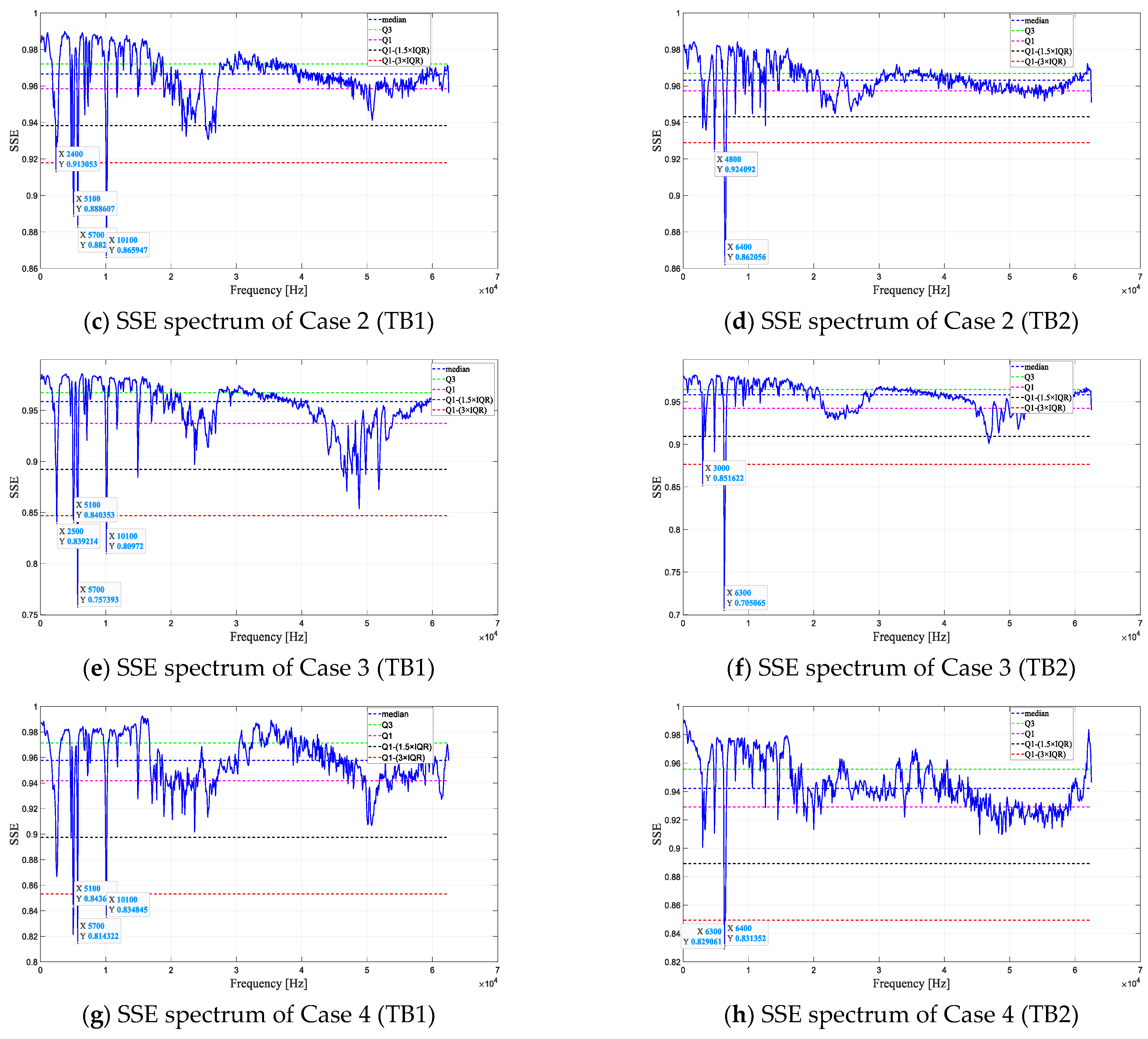

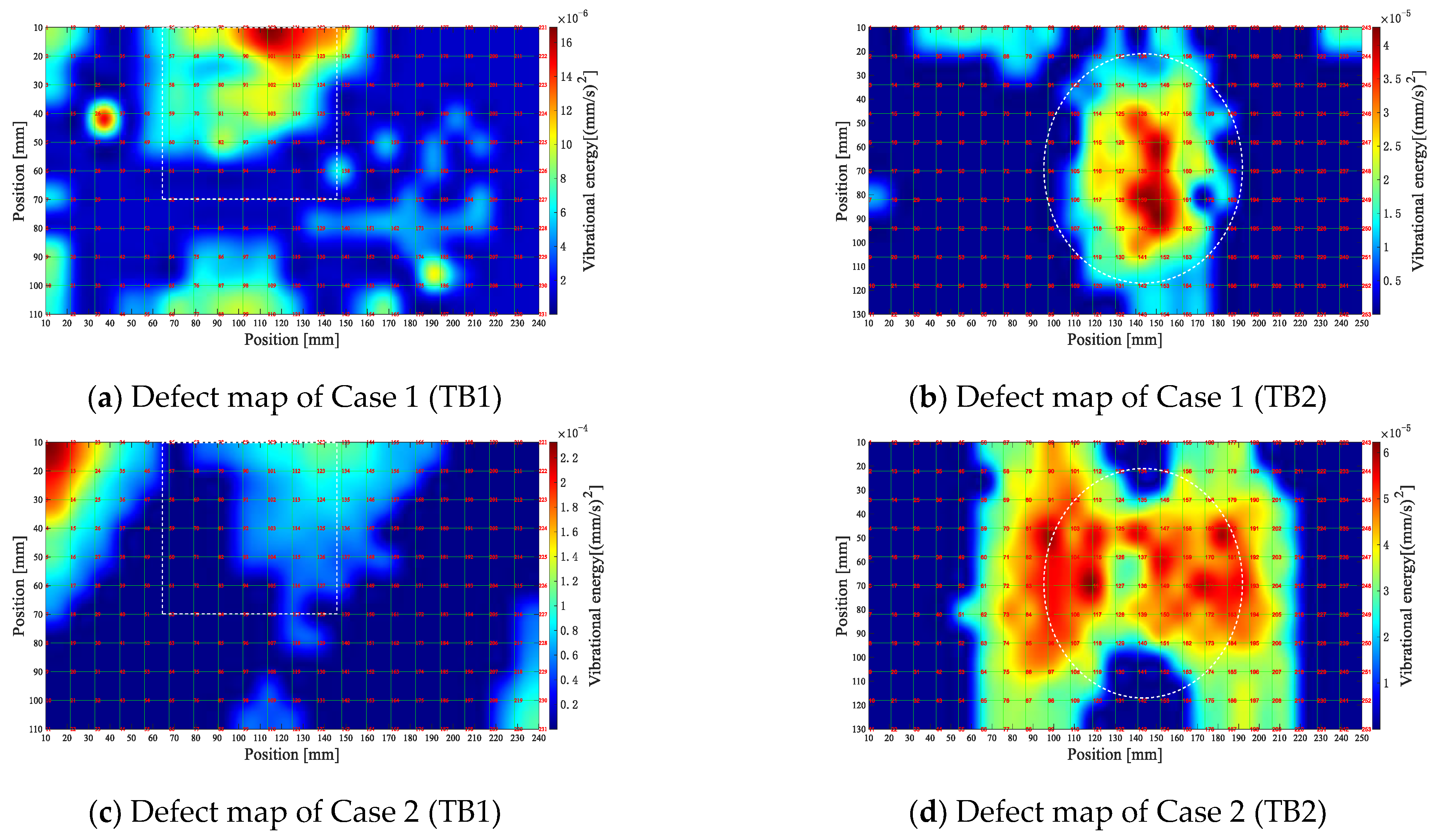
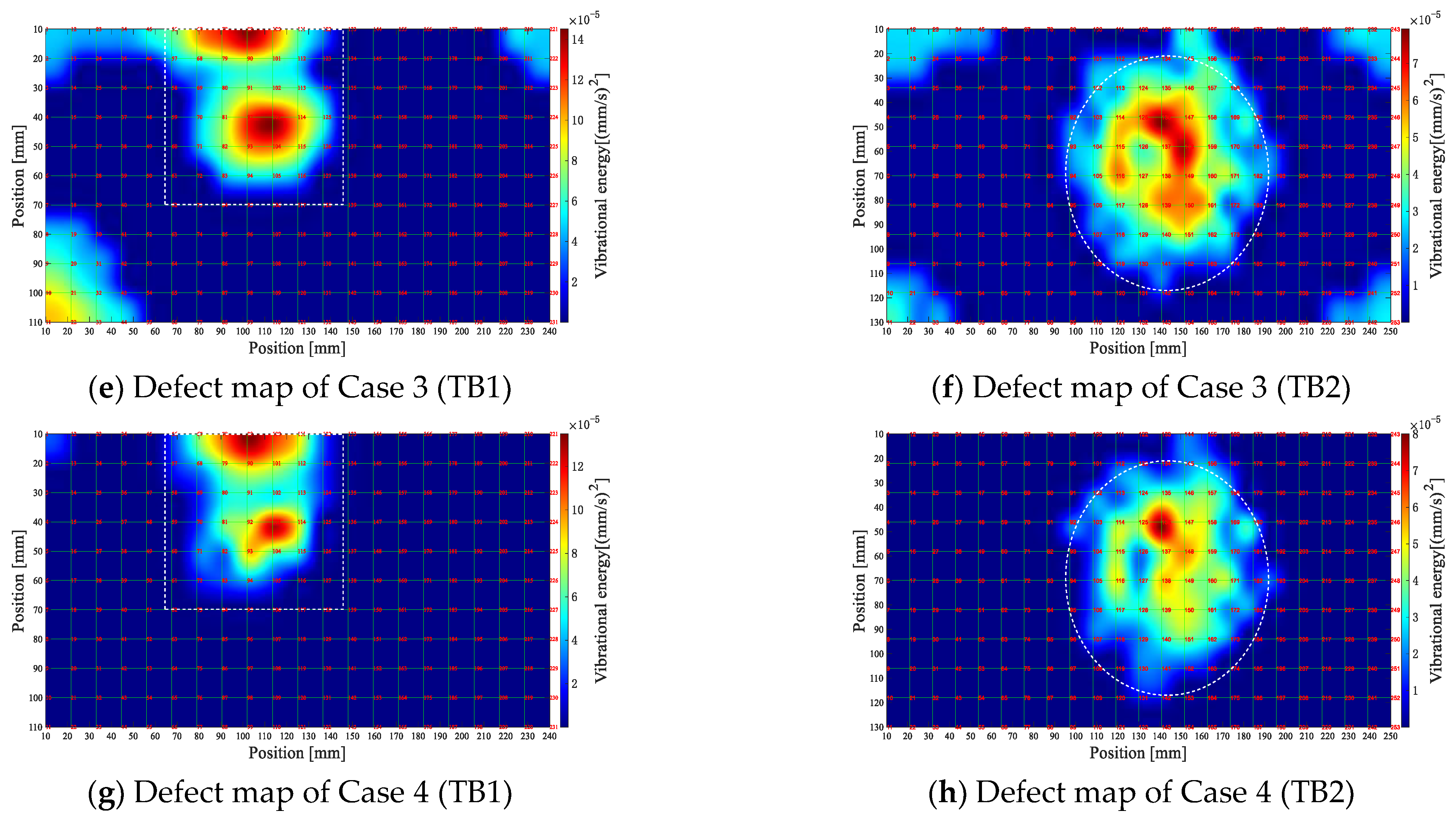

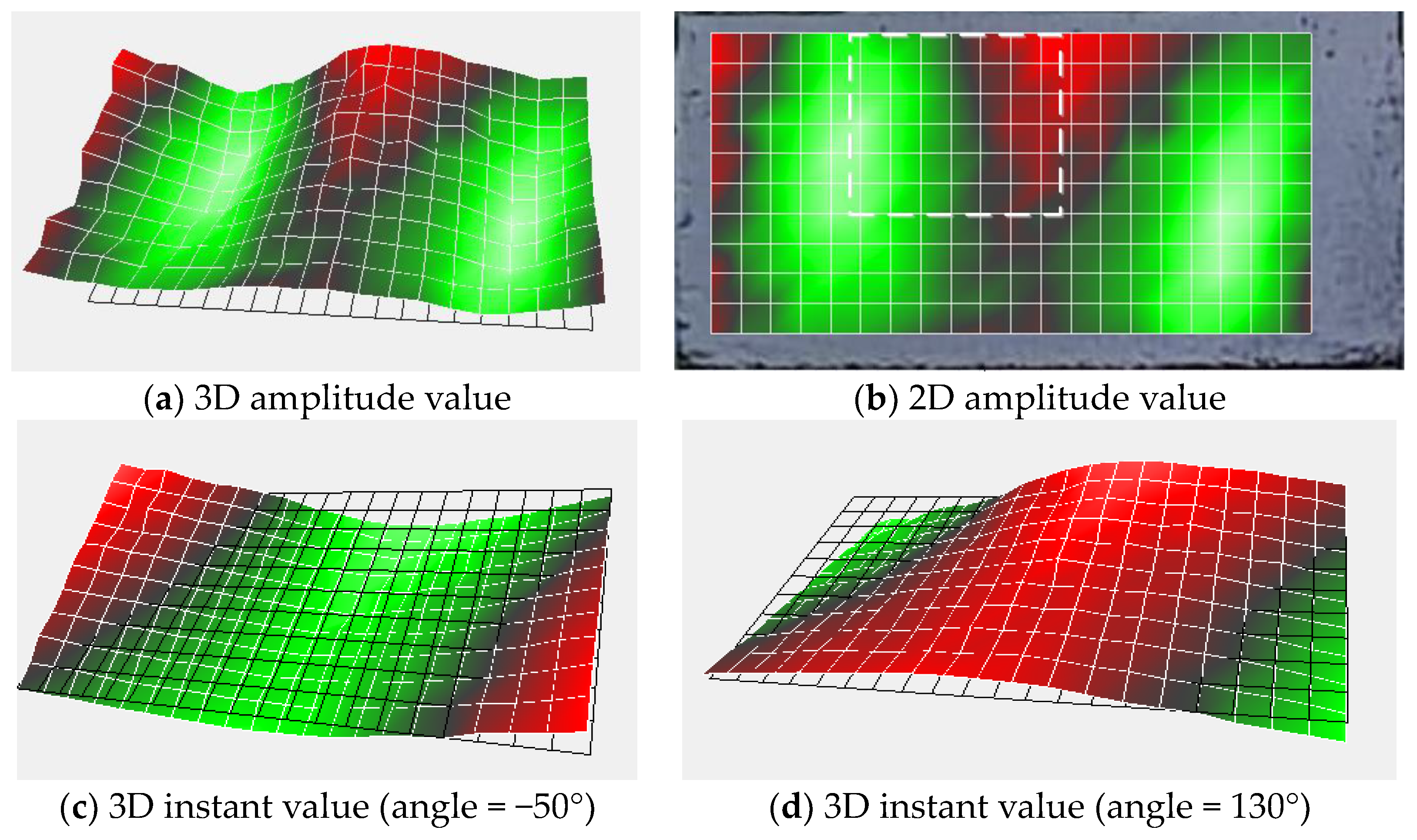
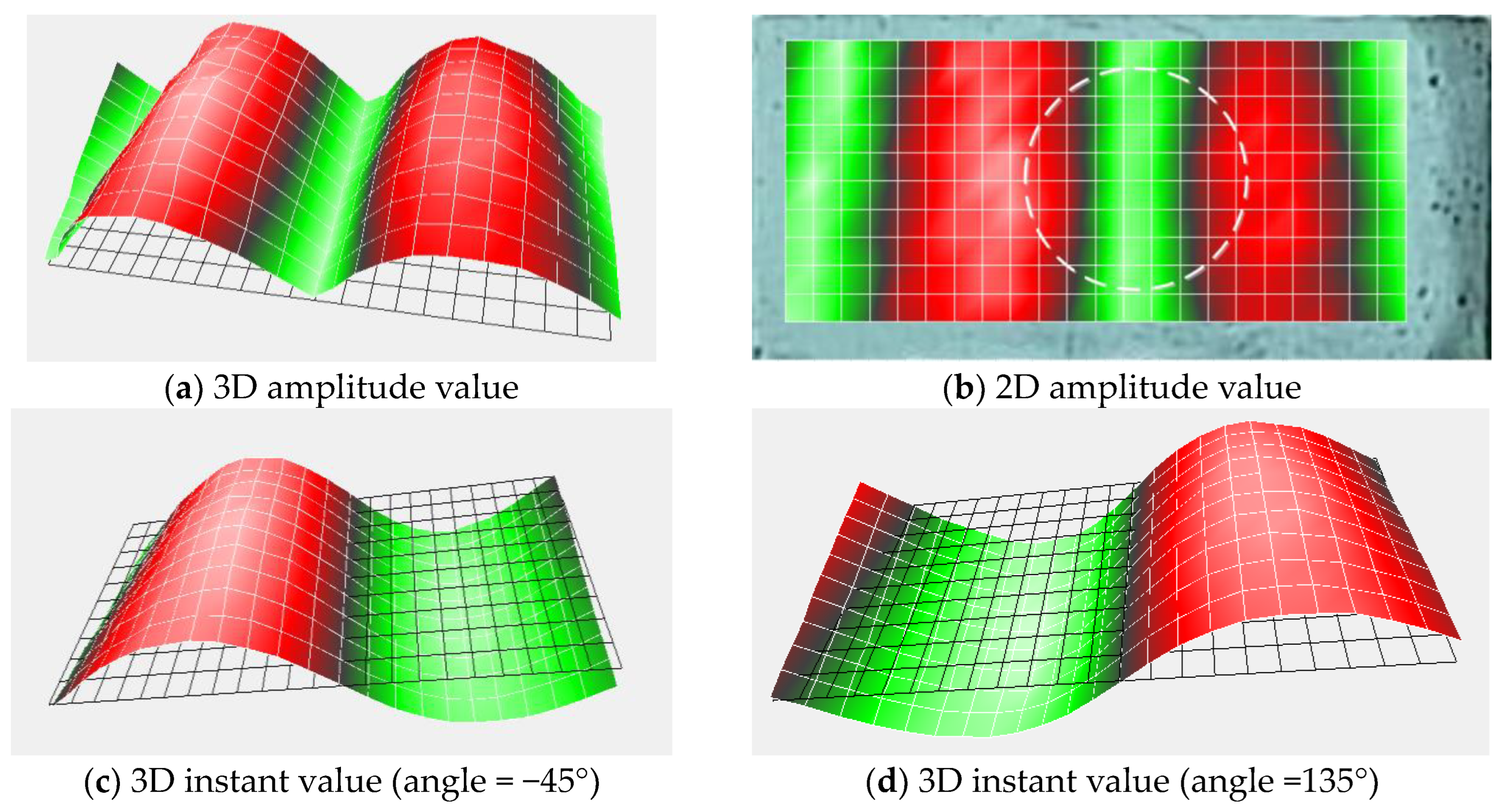
| Signal Processing Method | LMD+SVD | SSE | WSSE |
|---|---|---|---|
| Case 1 | - | √ | - |
| Case 2 | √ | √ | - |
| Case 3 | - | - | √ |
| Case 4 | √ | - | √ |
| Frequency (Hz) | Concrete | Correlation Coefficient |
|---|---|---|
| 5000&5100 | TB1 | 0.9801 |
| 5000&5700 | 0.9116 | |
| 5000&10,010 | 0.3745 |
| Frequency (Hz) | Concrete | w1 | Mean Vibration Energy (mm/s)2 | w2 |
|---|---|---|---|---|
| 800 | TB1 | 0.0326 | 2.8 × 10−9 | 0.4792 |
| 2100 | 0.1241 | 2.6 × 10−8 | 0.6649 | |
| 2300 | 0.1767 | 6.1 × 10−8 | 0.5323 | |
| 3600 | 0.0602 | 5.6 × 10−9 | 0.7576 | |
| 5100 | 0.4601 | 4.8 × 10−8 | 0.1951 | |
| 5700 | 0.4096 | 1.8 × 10−8 | 0.0228 | |
| 10,010 | 0.3379 | 1.6 × 10−8 | 0.0074 | |
| 700 | TB2 | 0.0628 | 1.8 × 10−9 | 0.2121 |
| 3000 | 0.2231 | 1.1 × 10−8 | 0.6266 | |
| 4800 | 0.2900 | 1.3 × 10−7 | 0.1754 | |
| 6300 | 0.3805 | 3.0 × 10−8 | 0 | |
| 8000 | 0.0679 | 9.2 × 10−9 | 0.1220 |
Disclaimer/Publisher’s Note: The statements, opinions and data contained in all publications are solely those of the individual author(s) and contributor(s) and not of MDPI and/or the editor(s). MDPI and/or the editor(s) disclaim responsibility for any injury to people or property resulting from any ideas, methods, instructions or products referred to in the content. |
© 2023 by the authors. Licensee MDPI, Basel, Switzerland. This article is an open access article distributed under the terms and conditions of the Creative Commons Attribution (CC BY) license (https://creativecommons.org/licenses/by/4.0/).
Share and Cite
Tian, X.; Ao, J.; Ma, Z.; Ma, C.; Shi, J. An Internal Defect Detection Algorithm for Concrete Blocks Based on Local Mean Decomposition-Singular Value Decomposition and Weighted Spatial-Spectral Entropy. Entropy 2023, 25, 1034. https://doi.org/10.3390/e25071034
Tian X, Ao J, Ma Z, Ma C, Shi J. An Internal Defect Detection Algorithm for Concrete Blocks Based on Local Mean Decomposition-Singular Value Decomposition and Weighted Spatial-Spectral Entropy. Entropy. 2023; 25(7):1034. https://doi.org/10.3390/e25071034
Chicago/Turabian StyleTian, Xu, Jun Ao, Zizhu Ma, Chunbo Ma, and Junjie Shi. 2023. "An Internal Defect Detection Algorithm for Concrete Blocks Based on Local Mean Decomposition-Singular Value Decomposition and Weighted Spatial-Spectral Entropy" Entropy 25, no. 7: 1034. https://doi.org/10.3390/e25071034





